[KRENtek Software, Atari]
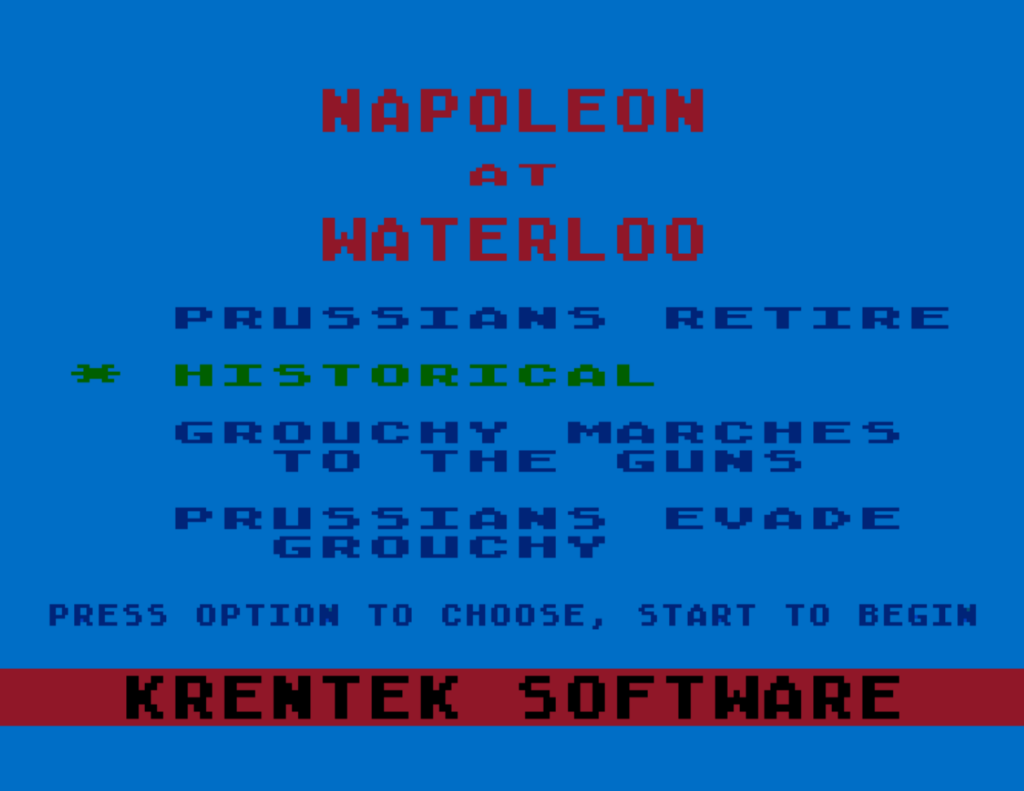
– Lieutenant Narwhal, we need you to win the battle of Waterloo!
– Again? I already won it, let me see, 3 times!
– This is an order Lieutenant, but don’t hesitate to press Fast Forward!
Legacy is a complicated thing. Sometimes you are a bright general with a stellar record, and when you are finally defeated after more than 10 years of warfare, everyone remembers your most brilliant victory, say Cannae. And sometimes, you are a bright general with a stellar record, and when you are finally defeated after more than 10 years of warfare, a song about your final defeat wins Eurovision.
I have played 4 Napoleonic games thus far, 3 of which involved changing the tide of history at Waterloo, so here we go again in KRENtek Software’s Napoleon at Waterloo.
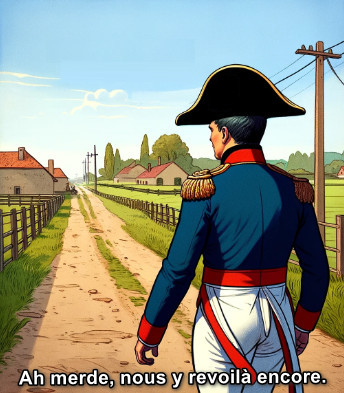
I am usually not a fan of Napoleonic wargames at the tactical level: either there is very little unit diversity (infantry/cavalry/heavy cavalry/guns), or there is a significant unit diversity (because of the quality of the soldiers, or their commanders, or their supply status), but all units look roughly the same so you need to remember which of your pixels are elite and which of your pixels will break before contact. Napoleon at Waterloo falls neatly in the second category, with units on the battlefield representing historical divisions, sometimes elite, sometimes not so much.
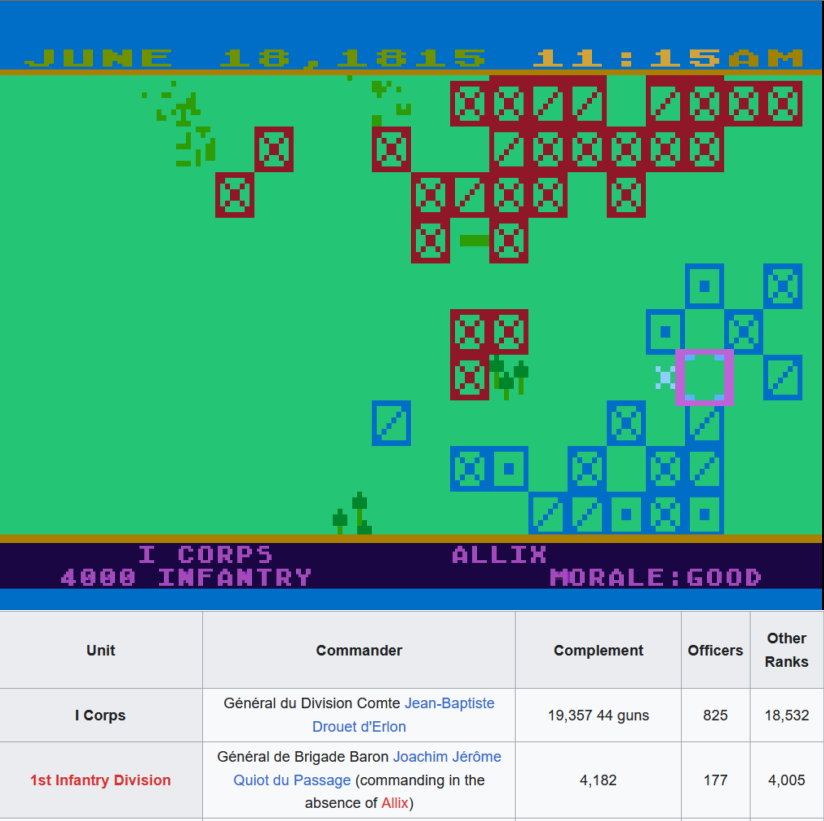
The game starts on the 18th of June at 11:15. It is paused, and that’s the last time it will be. The Coalition is already deployed along a ridge, with 3 fortified buildings as strong points: Hougoumont on their right, La Haye Sainte in the centre and Papelotte on their left. On the French side, my troops only started arriving, with a good chunk of my force still in column in the back.
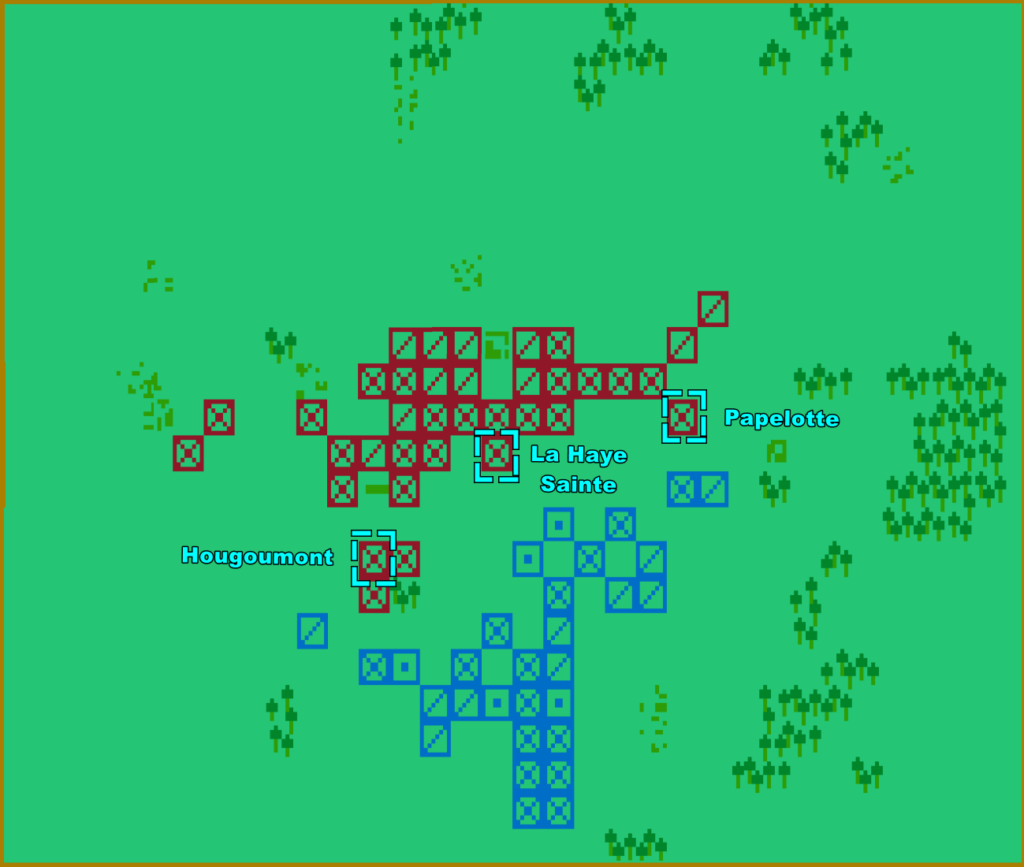
As per the rules, the fortified farms offer great defence against direct assault.
My initial plan is:
- on my left, to surround Hougoumont to be ready for an assault from all directions,
- on my right, deploy my units in line to prepare for a frontal assault, as the British left is quite loose,
- on the centre, deploy my artillery in the centre to blast the British at close range. If they move to attack my artillery, they’ll lose their defensive position and I am fine with that. If they don’t move, they’ll die and I am fine with that as well.
The coalition remains still as I deploy, and I am soon more or less positioned the way I wanted to.
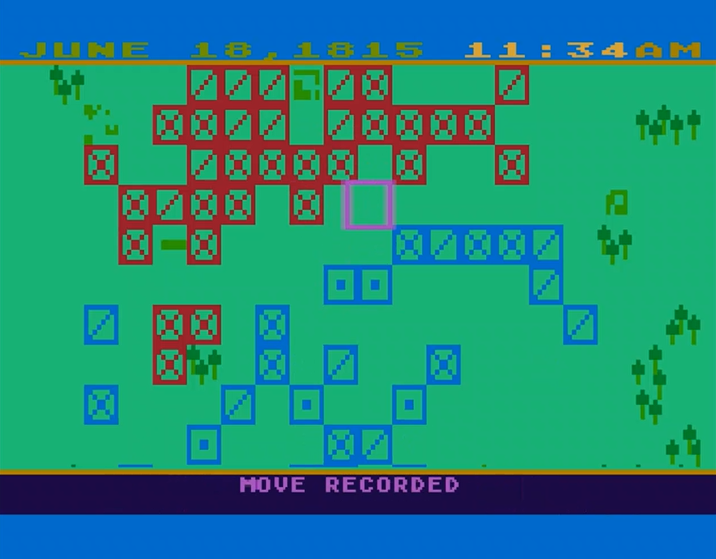
The battle starts for real with my guns shooting at the British centre, shortly before I organize an assault on Hougoumont. I advance from all directions, first stopping just in front of the Anglo-Allied forces so my infantry can use their muskets (range=1), after which I engage in melee with both my infantry and my cavalry. The assault is successful, and the coalition abandons the fortified farm:
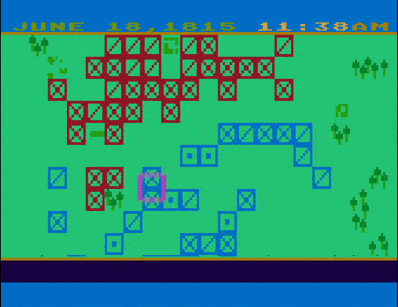
One hour into the battle, and I have already taken Hougoumont, which historically Napoleon never managed to hold and had become “a battle within the battle”.
While I form a new line on my left, I have some time to focus on my right. I wish I could order an all-out assault and be done with it, but apparently that’s not era-appropriate anymore. Instead, the manual recommends attacking enemy divisions by coordinating infantry and cavalry so they hit the enemy at the same time, as the way infantry formed to protect against cavalry was inefficient against infantry. It takes two attempts to coordinate properly (on the first attempt, my units fall back), but the second time I manage to force the Anglo-Allied to fall back.
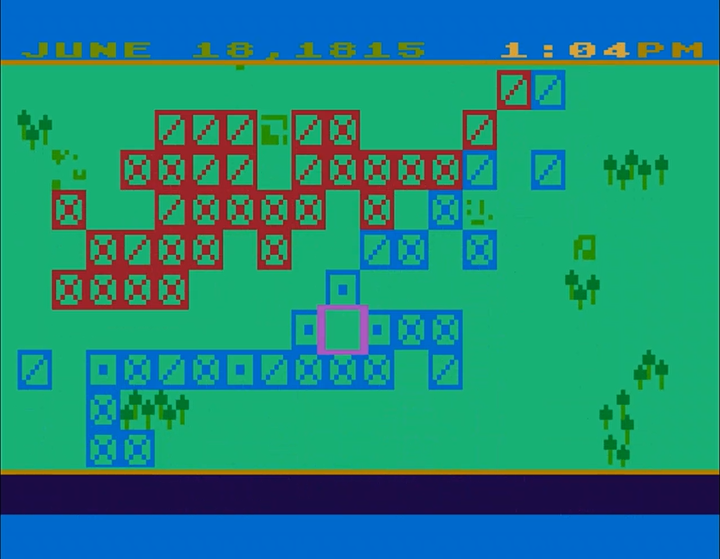
Once the coalition’s strong infantry divisions have retreated, I directly charge the smaller ones and the English cavalry. Wellington’s left wing collapses and retreats, with my cavalry and some infantry in pursuit.
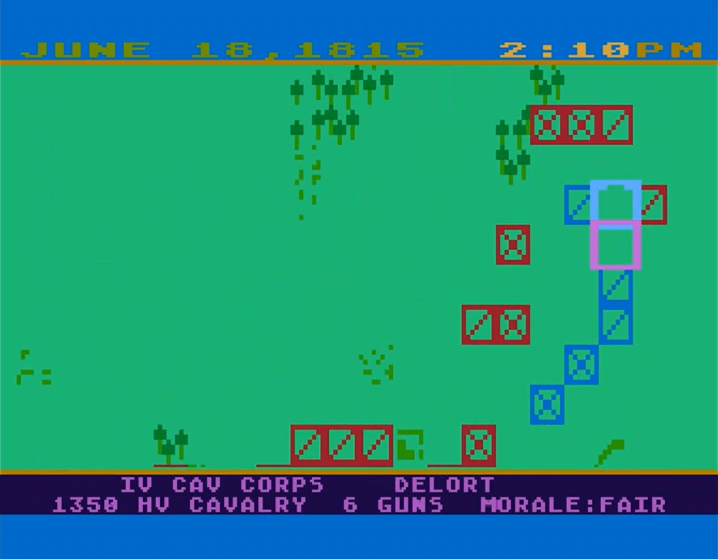
Pursuit is frustrating in Napoleon at Waterloo: the only order you can give is “move to (or shoot at) a location“, and of course retreating enemies don’t have the courtesy to stop in front of your guns. Worse, units can move in diagonals so you cannot block them either. It’s as frustrating as trying to catch running water. Eventually, I position one cavalry division by row and give them orders to move 10 tiles to their left, pending a later order to move 10 tiles to their right, and so on. This turns the back of the battlefield into a game of Frogger for the retreating Anglo-Allied, but that’s the simplest way to prevent them from regrouping while attending to the rest of the battlefield.
Once I’m done, I turn my attention to Hougoumont again. There, I am facing the Dutch-Belgian Corps, which I remember from Computer Napoleonics as being low-quality. I send a probing attack… and the Dutch-Belgians fall back almost without combat!
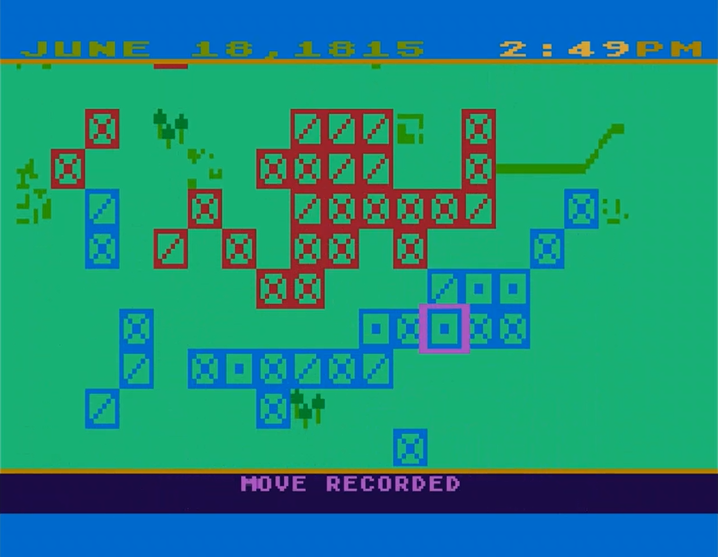
Only 20 minutes later, the rest of Wellington’s right wing retreats!
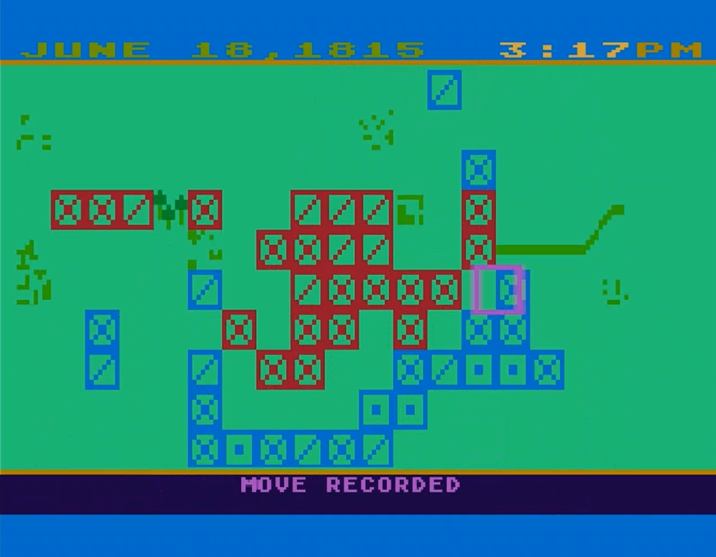
Well, now I only need to deal with the centre of Wellington’s army. I am initially confident that my guns have weakened the British enough, but a direct frontal assault on La Haye Sainte fails. I adapt and attack the “corners” one after the other. This time, it works.
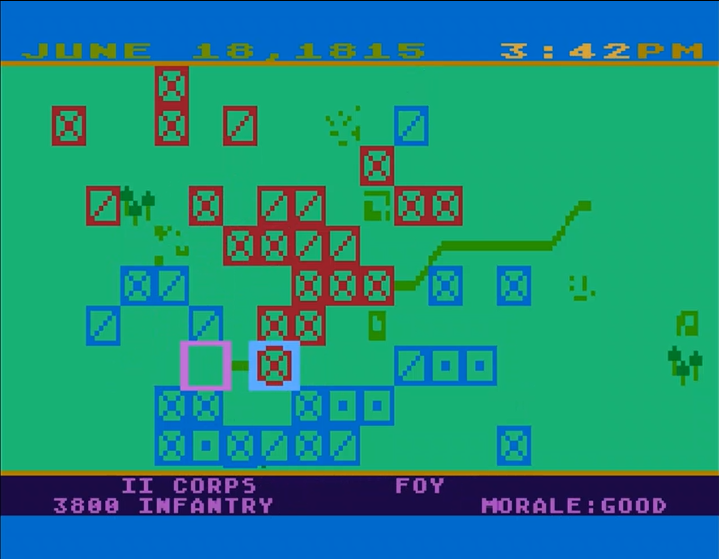
Suddenly, my emulator plays an 8-bit version of the Marseillaise. This means the enemy is routing, and they retreat every time I attack. I send as many units as I can in pursuit in the least subtle way possible, the only reason I don’t send more people in pursuit is that I don’t materially have the time:
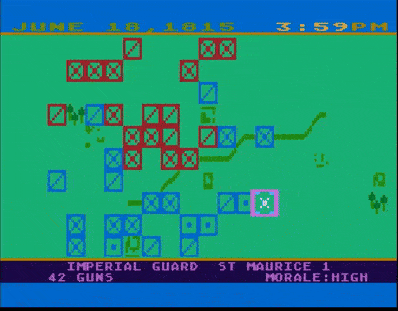
As I check the map, I realize I received some reinforcements in the East. It must be Grouchy who marched to the sound of the gun, but I don’t really need him as the battle is over…
….wait… why can’t I give orders to Grouchy? Oh no! That’s the Prussians, and unlike the British they are moving, and moving fast.
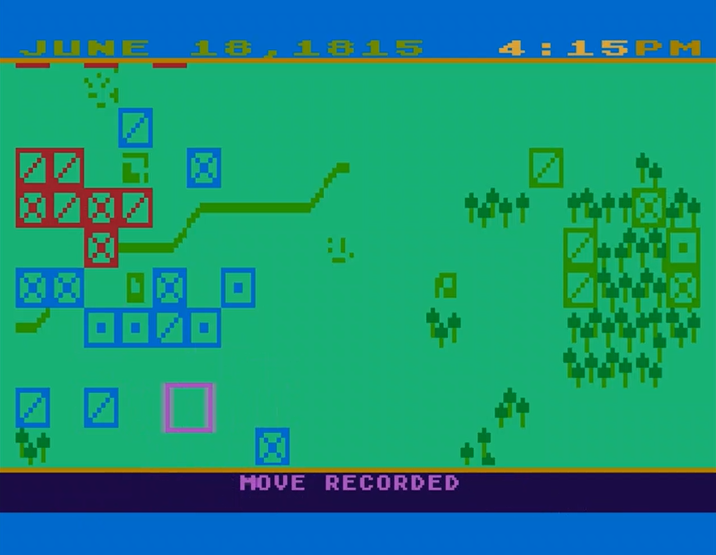
I immediately start forming a line of guns and infantry between La Haye Sainte and Papelotte, before realizing I would be better off fortifying the line running between La Haye Sainte and Mont Saint Jean North of it. Soon after that, I realize that guns don’t run as fast as men so now I have my guns alone!
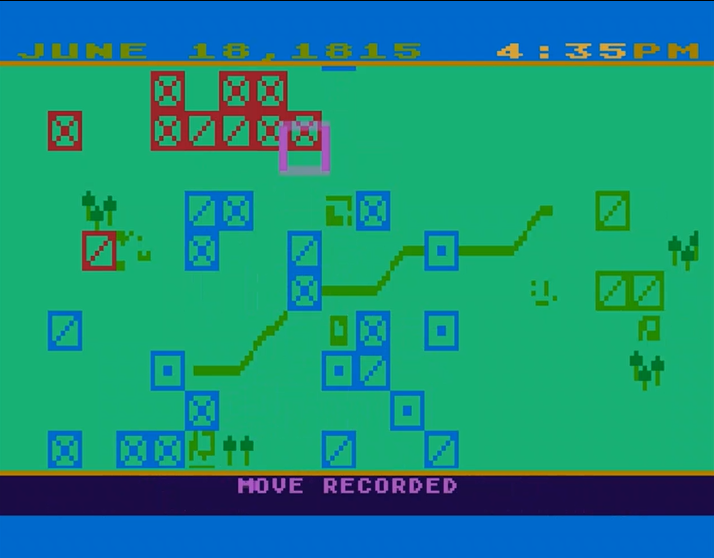
I bring my cavalry for support, but in the commotion I fail to notice that the one I picked up was out of juice.
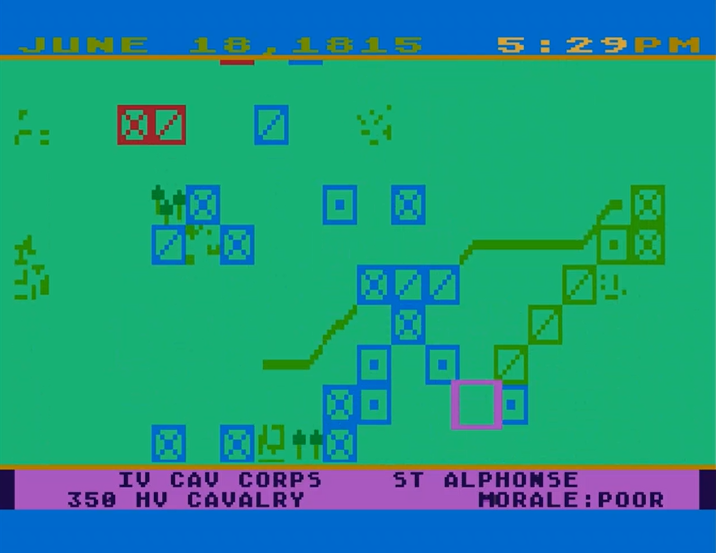
My cavalry decides not to stay around, and one of my artillery divisions is run over. I manage to fall back with the other, finally establishing my line.
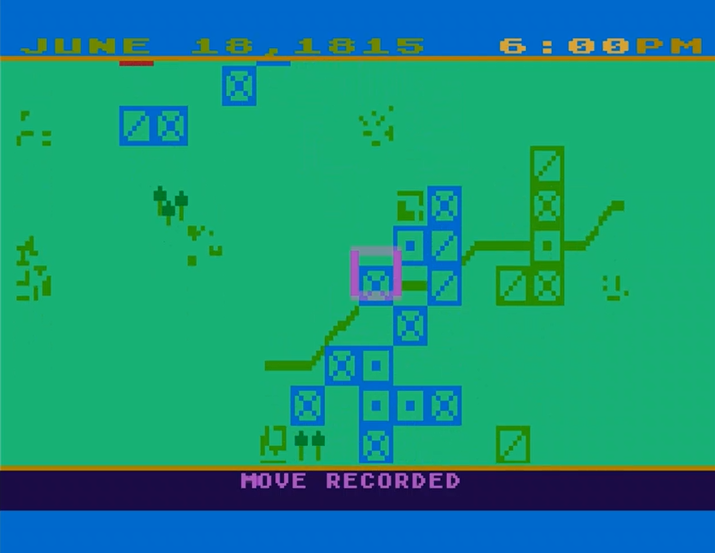
The rest of the battle is essentially an artillery duel. Initially, I am not helped by the fact that every time the Prussians move I need to give a new order to all my artillery divisions. Later, the Prussians decide to focus on my infantry occupying La Haye Sainte. I know from my experience attacking Wellington’s infantry occupying the same farm that infantry in farms is all but immune to artillery, so I hold my position. This means the Prussian guns don’t move and that the Prussian infantry attacks through a predictable path, and I can finally use my own guns to their full effect.
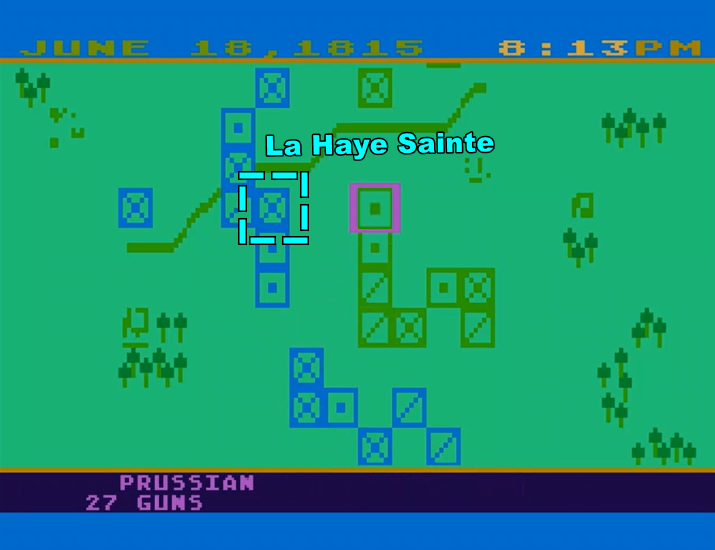
The Marseillaise rings again: the Prussians are routed! There is now less than one hour of battle left, which I use to inflict as much damage as possible on the retreating Prussians with those units that were finishing off the Anglo-Allied:
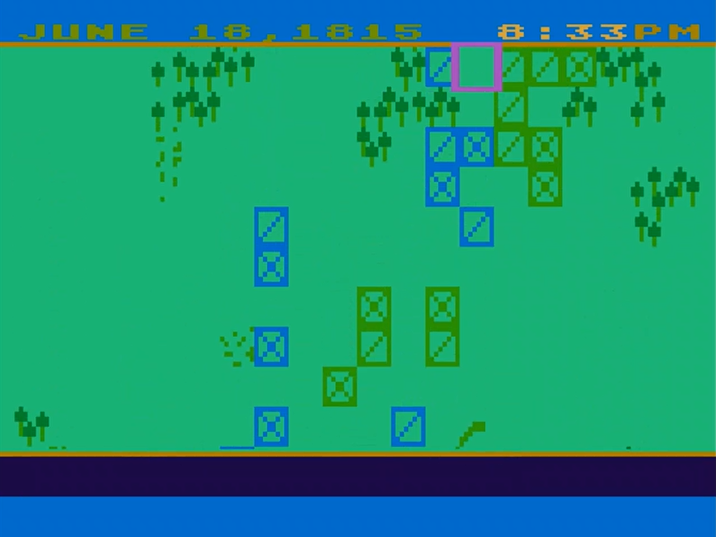
That’s the end of the battle. A score of 100 000 is a decisive victory, and I had 150 000, inflicting 2 casualties for each one of mine.
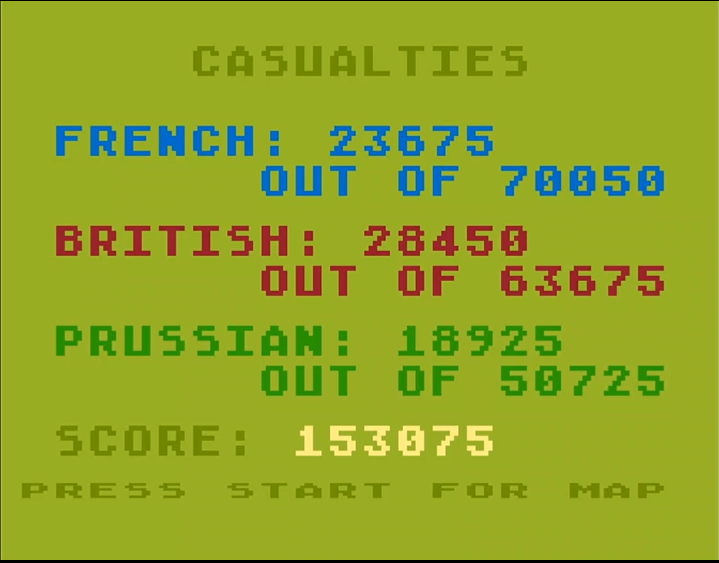
Once again, I have proven that Napoleon should have won that battle.
Ratings & Reviews
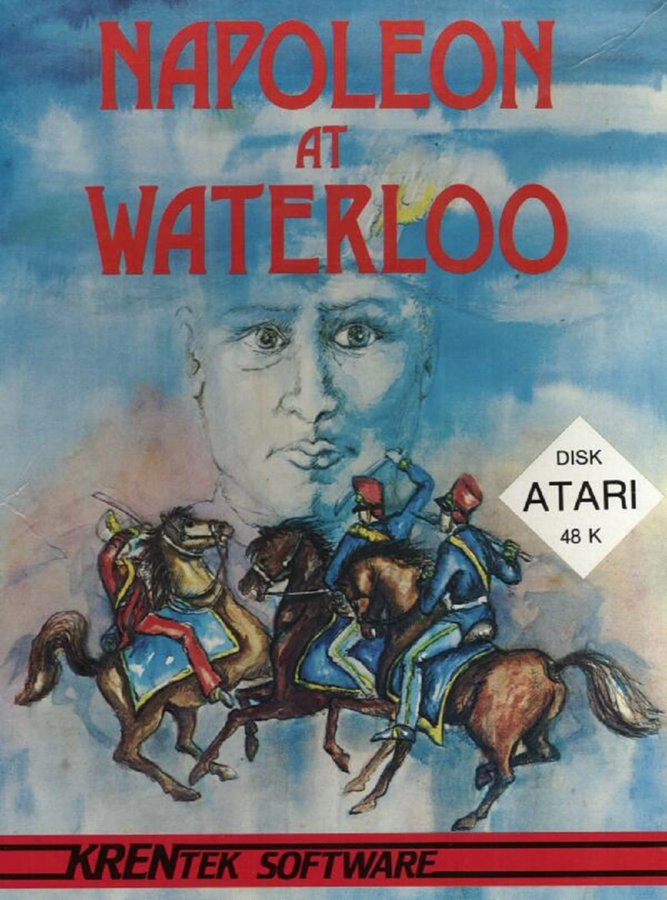
Napoleon at Waterloo by Steve Krenek and Dave Simmons, first published by KRENtek Software
First release: June 1984 on Atari
Genre: Battlefield Tactics
Average duration of a campaign : 40 minutes
Total time played: 45 minutes
Complexity: Easy (1/5)
Final Rating: Obsolete
Ranking at the time of review: 83/133
Napoleon at Waterloo is one of the 2 games released in June 1984 by KRENtek Software, a company founded by Steve Krenek in Kansas. I have little information on Steve Krenek, except that he was for several years the Group Moderator of the Computer section of BIX, a BBS run by the BYTE magazine. KRENtek Software released 3 games (Napoleon at Waterloo and Rome and the Barbarians in 1984, Napoleon in Russia: Borodino 1812 in 1986), and then a last one (Napoleon vs the Evil Monarchies: Austerlitz 1805) in 1989 under the new name Cornerstone Software. As for the game itself, it was initially released on Atari only, and only later (1986?) received a Commodore port . The game received two versions, with the second version in 1985 adding the 3 alternative scenarios.
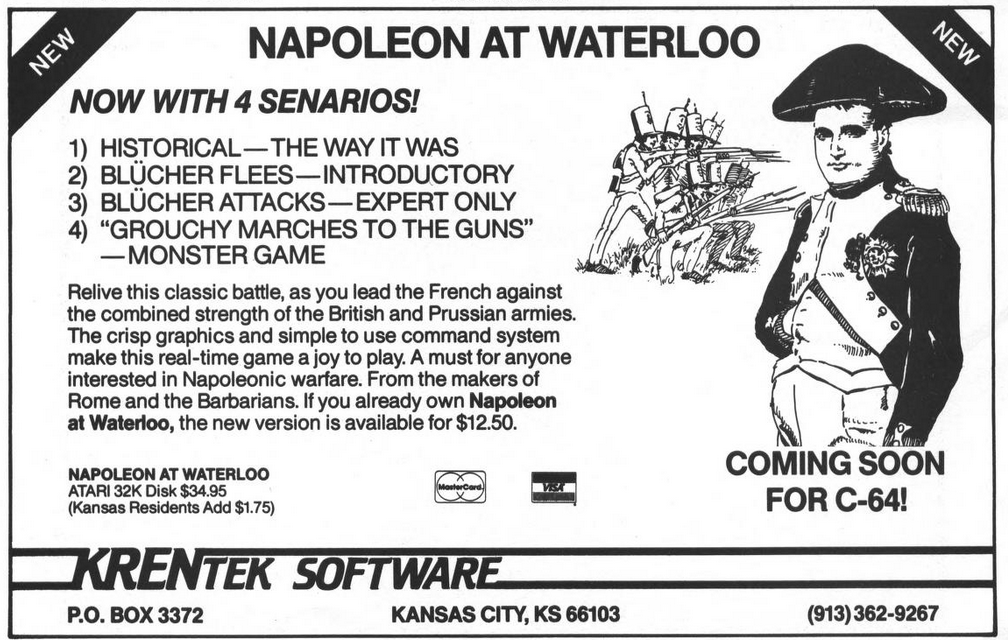
Napoleon at Waterloo is clearly inspired by Chris Crawford’s Legionnaire. I did not like Legionnaire, but in it Crawford made sure that the UI, the ruleset and the fantasy were all aligned. It is unfortunately not the case in Napoleon at Waterloo.
The manual describes a Napoleonic game, in which you need to use Napoleonic tactics to triumph. For instance, the key to destroy the enemy is the use of cavalry and infantry in conjunction:
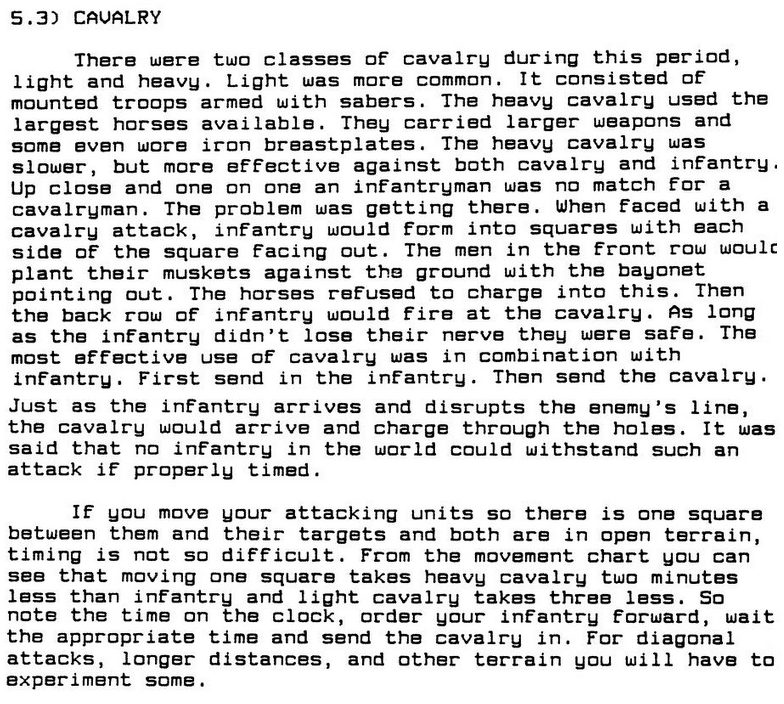
Unfortunately, the game does not play as a Napoleonic game. To start with, the visuals are not functional: you don’t know which units are moving and which units are retreating, you don’t even know which units are fighting and which units are just adjacent, and of course you don’t know whether infantry divisions have formed squares or not.
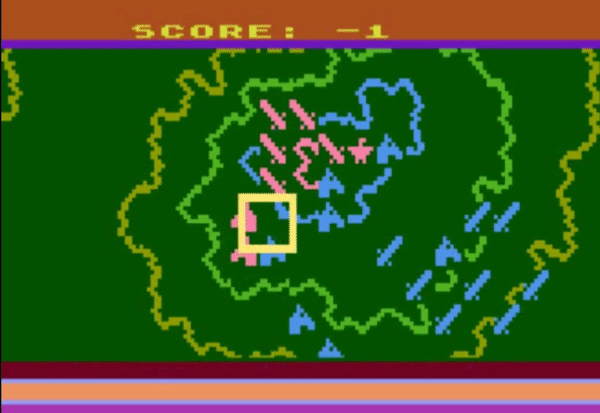
To make things worse, the game is too fast for the scale. Units move so fast that you need to keep updating your movements when in pursuit or when confronting the Prussians. When fighting the Prussians, my units routinely moved in front of my guns before I could stop them, guns that were firing at an empty position because of course the Prussians kept moving – I probably lost thousands of troops this way. Worse still, melees are solved in seconds, with one unit or the other almost immediately retreating upon contact – in diagonals between enemy units if needed! This means that the trick described in the manual where you attack at the same time with cavalry and infantry needs perfect timing, and given the game is going so fast everywhere you have better things to do than micro-manage every single attack. By mid-game, I was playing it like an Alexander with guns: try to flank the enemy divisions and attack them one after the other with as much force as I could, hope that the enemy break, then pursue with cavalry – and goodbye Napoleonic fantasy!
I rate the game Very poor in all four categories. I did make some decisions in my playthrough, but only a few of them – the rest was busywork either trying to implement them or trying to catch enemy units. The game is obsolete, though not totally unpleasant to play once. I did not like Legionnaire much, but as far as real-time tactics was concerned it was way above this game. As for the theme, even the ageing Computer Napoleonics, as broken as it was, was more fun to play.
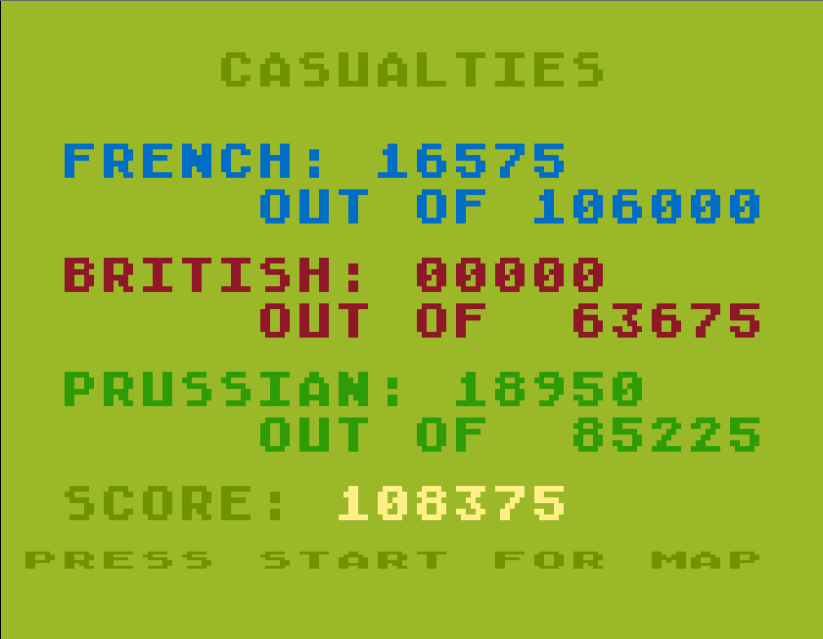
Reception
Napoleon at Waterloo received overall good but rarely enthusiastic reviews. For instance, Mark Bausman writing for Computer Gaming World (June 1986) reckons that “this game has a lot going for it“. Similarly, Bob Cockcroft explains in Rom Magazine in February 1986 that “Napoleon at Waterloo is a simple but entertaining simulation of Napoleonic warfare. After playing this game a number of times, I have not found any serious weaknesses.” More surprisingly to me, Evan Brooks gives the game 3 stars in his review of all pre-modern wargames, though he warns that Napoleonic tactics won’t work in the game. The only more nuanced voice is the one from Mickael Ciraolo who appends a short review of Napoleon at Waterloo to a longer one of Rome and the Barbarians, and explains: “Napoleon resembles the study an artist produces prior to painting a masterpiece. It’s a good warm-up to Rome”.
I suppose this is the exact same situation as for Legionnaire. For the 2024 gamer, used to real-time wargames, the game has nothing redeeming, but for the 1984 gamer having units move in real-time was a unique experience in itself, and enough to consider the game at least entertaining, if not better.
What puzzles me more are the comments about difficulty. Bausman claims he never beat 78 000 points, whereas Nick Chrones writing for the Wace New Zealand Atari Computer Club is proud to claim that he scored “high 90 000s several times”. I suppose players trying to win with doomed historical tactics (Bausman explained he attacked in the centre near La Haye Sainte) are bound to lose, but maybe I also underestimate the impact of being familiar with real-time strategy games as we all are nowadays?
We’ll soon see whether I maintain such a high performance in KRENtek’s Software second 1984 game: Rome and the Barbarians.
7 Comments
The ad for CGW has a typo (“senarios”) on the second line. Not the kind of thing that inspires confidence in the quality of the product.
Well, another game under your belt. While it’s more entertaining to read reviews about excellent or horrible games – and this one even lacks your typical witty intro in italics – it’s good for the gaming history that you provide coverage of these middle-of-the-road games. Congrats for your n-th victory in Waterloo, Emperor!
I have mixed feelings about my intros, but I added a new one here just for you!
Hey, that was super nice! But, don’t feel obliged to hear us fans, the important thing is that you continue to enjoy what you are doing. Thanks and happy gaming!
Just wanted to say how much I enjoy this blog! I’m finally caught up, after discovering it last year and slowly reading through each entry from the beginning. Fantastic historical resource, and extremely well-written (and funny!) to boot.
Sort of related to this particular game: Any chance you would consider covering Avalon Hill’s “Paris in Danger” at some point? I know you try to stay away from multiplayer-only games, but it does look kind of interesting…
Thanks for your nice words, and thank you for soldiering through the first articles. Re-reading them todays, well, it was before I found my style and before Grammarly, and it shows :).
I think you are the second person to mention Paris in Danger, so maybe I’ll find a volunteer for a PBEM and test it eventually. No promise, though!
At least it’s not Waterloo.
Another superb review. A historical wargame that doesn’t feel historical just isn’t right. I’ve got a Waterloo game where the Prussians can concentrate in a farm early on and just wipe out the French at Wavre and it ends before Waterloo even begins!
Or like the old “Battle of the Bulge” board game I inherited from my father. The Germans are so overpowered that nothing the Allies can do ever slows them down from sweeping all the way up to the Channel. Not so much reply value when a game feels so unbalanced!